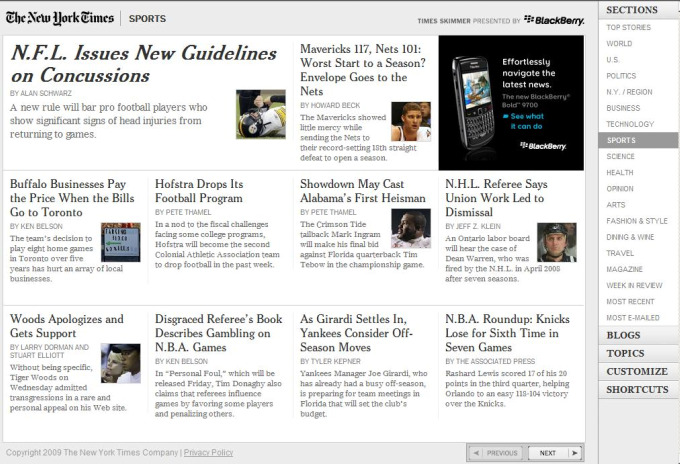Saving Print Media by Design

It's true - the print industry is in a bit of a pickle. Advertising revenue and subscriptions are way down. The industry is in the midst of completely restructuring itself to save itself. But print is not dead. In fact, it's making a comeback, in a digital way. There's no greater evidence of that than Amazon's Kindle and Barnes & Noble's sold-out Nook. Both devices attempt to recreate an "unplugged" reading environment, right down to the design of e-book pages.
Ask regular print readers - especially those of newspapers - how they feel about online news and you will likely get a response something like this: I like the convenience of reading news online, but I still like flipping through the pages of a newspaper. The experience of reading is important to many people. It's a lifestyle, not just a convenience. The publishing industry knows this; and their designers are taking steps to bring the ritual of offline reading online.
Take a look at a new feature from The New York Times, called "Times Skimmer," pictured below. To the right are "sections" such as Top Stories, World, Politics and Sports. Clicking any of them will show the top stories for that section with brief descriptions. The page itself features simple text, headlines and photos, in line with a newspaper feel and in stark contrast to the regular nytimes.com home page that features blue links everywhere, ads (static and animated), video and hundreds of options to click. In short, it's a much more relaxed reading environment and encourages exploration. Article continues below...

Time Inc is also working on a "throwback" of sorts to print media with it's digital magazine concept. Again, the ritual of reading is replicated by encouraging the turning of pages and browsing the content. Of course, there are digital enhancements but the main goal is to draw the reader in, let them relax and shuffle through the content (see video below).
For publishers, this attitude toward a print media "revival" reminds us that many readers still want to actually read a publication - at their leisure. Not all readers are "blog people." One of the advantages print will always have over digital is that it's much easier to hold a reader's attention. In a clickable format, it's far to easy to click somewhere else, leave the website, or even get lost on the current site. If this trend of adapting the reading ritual to online properties continues we could see longer time-on-site for publishers, as well as a lucrative opportunity for advertisers to brand themselves with a captive audience. This kind of design could also work to help struggline print publishers shift their look and feel to the much more affordable online channel without alienating current readers. Worth noting, for sure.

Subscribe to Our Newsletter!
Latest in Web Design








